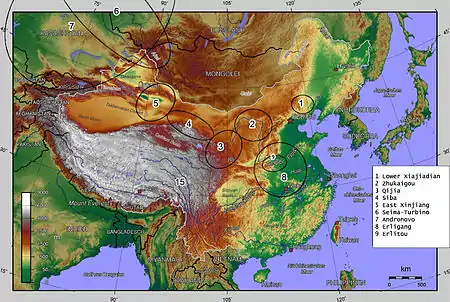Siwa culture
The Siwa culture (Chinese: 寺洼文化; pinyin: Sìwā wénhuà) was a Bronze Age culture in southeast Gansu Province, China. It was discovered by Swedish geologist Johan Gunnar Andersson in 1924 at Mount Siwa (寺洼山) in Lintao County, hence its name.[1] It flourished circa 14th to 11th century BC,[2] it is tentatively attributed to the cultures of the Northern Di, Qiang, and Xunyu peoples.[3][4]

The archaeological culture is divided into two phases: the early phase associated with the sites at Lintao, Zhuoni, Lintan, and Heshui; and, the final phase during the late Shang and proto-Zhou periods associated with the Jiuzhan, Xujianian, and Lanquiao sites.[5] Siwa culture is known for producing a type of pottery that had saddle-shaped mouths.[5]
Context
The neighboring Xindian culture was roughly contemporary with the Siwa culture and was influenced by it. Some scholars hold that Siwa culture descended from the Qijia culture.[6] There are also those who believe that the culture was a remnant of Xunyu, which is associated with the Xianyun people. However, questions are raised against this theory since Siwa sites are small with low subsistence levels.[7] According to archaeologists, these could not have sustained an advanced society like the Xianyun.[7]
Geography
Siwa culture is divided into two types – Siwa and Anguo. The former is distributed along the Tao River (Taohe) and the latter along the Wei River. The Siwa type is somewhat earlier than the Western Zhou dynasty, while the Anguo type is more or less contemporaneous with it.[8]
One of Siwa culture's main characteristics is pottery with saddle-shaped openings (马鞍口陶罐),[9] It is also distinguished by its bronze objects.
Since 2006, the Siwa site (寺洼遗址) is on the list of the People's Republic of China's archeological monuments.
References
- These sites are also called Miaopingyagou yizhi 庙坪鸦沟遗址.
- "灞陵桥寺洼遗址成为全国重点文物保护单位--中国甘肃网". Archived from the original on 2012-03-16. Retrieved 2011-01-11.
- Hu, Qianying 胡謙盈, "Lun Siwa wenhua" 論寺洼文化, Wenwu jikan 文物集刊 2 (1980), 123-4 of 118–24. Cited in Li, Feng (2006), Landscape And Power In Early China, Cambridge University Press. p. 187
- 甘肃日报 [Gānsù Rìbào, Gansu Daily]. 《走进临洮县寺洼文化遗址》 [Zǒujìn Líntáoxiàn Sìwā Wénhuà Yízhǐ; "Entering Lintao County's Siwa Ruins"]. 2007. Accessed 17 Dec 2013. (in Chinese)
- Linduff, Katheryn M.; Sun, Yan; Cao, Wei; Liu, Yuanqing (2018). Ancient China and its Eurasian Neighbors: Artifacts, Identity, and Death on the Frontier, 3000–700 BCE. New York: Cambridge University Press. p. 168. ISBN 978-1-108-41861-4.
- Anne P. Underhill, ed., A Companion to Chinese Archaeology. Wiley Blackwell Companions to Anthropology. John Wiley & Sons, 2013 ISBN 1118325788
- Feng, Li (2006). Landscape and Power in Early China: The Crisis and Fall of the Western Zhou 1045–771 BC. Cambridge: Cambridge University Press. p. 187. ISBN 978-1-139-45688-3.
- An Zhimin (1996), THE BRONZE AGE IN EASTERN PARTS OF CENTRAL ASIA. (PDF) Unesco.org
- "Far East Asian Art". Archived from the original on 2012-07-30. Retrieved 2011-01-11.
Further reading
- Nicola Di Cosmo (1999), The Northern Frontier in Pre-Imperial China//The Cambridge History of Ancient China: From the Origins of Civilization to 221 BC, Edited by M.Loewe and E.L.Shaughnessy. ISBN 0-521-47030-7